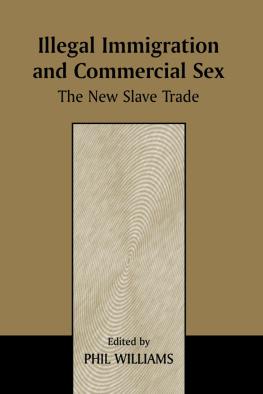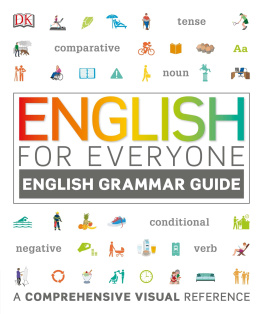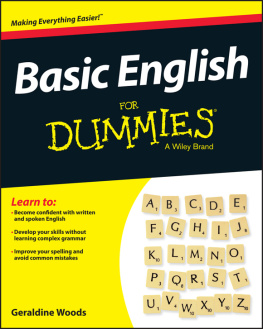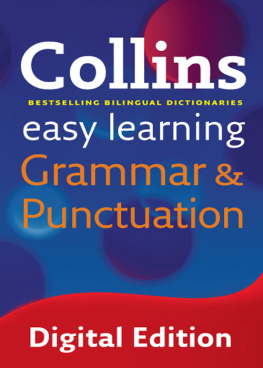Word Order
in
English Sentences
Phil Williams
2 nd Edition
Copyright 2016 Phil Williams
All rights reserved.
Designed by P. Williams
No part of this publication shall be reproduced, transmitted, or sold in whole or in part in any form without the prior written consent of the author.
Visit www.englishlessonsbrighton.co.uk for more information
and regular ESL updates.
Contents
Preface
This guide is for English learners of all levels who want a full introduction to word order and sentence structure in English. Starting at a basic level, it gradually introduces more complex sentence structures and components, and provides plenty of practice through rearranging words to make sentences. An understanding of English may be necessary before beginning.
The basic rules presented here are important as a basis for more complex grammar later. A strong and flexible use of English is made possible through a solid understanding of the more simple initial rules; in English the rules are often bent and broken, but to do this effectively you must first know the rules.
You can use this book by reading through different sentence structure and word order rules one at a time, in sequential order, or by using the contents as a reference to find information on specific items.
This grammar book is written in English. Translations will be available in the future.
About the author
Phil Williams is an English teacher and writer based in Brighton, UK. He has taught in schools and privately, in the UK, the United Arab Emirates, Russia and the Czech Republic, and is qualified with a Trinity Certificate in TESOL, and a Trinity IBET for Business English. He writes for businesses and entertainment, and manages websites - including the regularly updated ESL website English Lessons Brighton.
Phil also runs the writing websites if you have any questions or comments regarding this book.
Acknowledgements
This book would not have been possible without my many students who have helped me understand the importance of specific grammar points and the difficulties learners have with them. In particular I must thank my wife Marta for her support and reading through this with me, and my readers who gave early feedback, particularly Kate Phillips, Marie-Claire Gauthier, Elmer Jadraque, Dmitri Nikolaev and Pedro Rojo.
Much of what I know about the English language I have learnt from reading and writing practice, and through answering the questions of my students. Two grammar books that have also greatly benefited me are Murphys English Grammar In Use and Swans Practical English Usage . Both of these books cover a vast range of grammar points, and are worth reading (and owning).
Introduction
In the English language, word order and sentence structure are important. Changing the order of words, or the structure of a sentence, can affect meaning. However, the English language is also flexible, and in many cases the order can be changed.
This guide is designed to introduce the basics of word order and sentence structure, and to provide general points on how word order and sentence structure can change. It does this by first introducing simplified components of English sentences, such as Subject-Verb-Object rules, and develops these ideas with more detailed analysis of the components, considering nouns, verb phrases, questions, prepositional phrases, adjectives, adverbs and more.
After covering these general rules, consideration is given to more advanced use of English, including rewriting English sentences with different structures, analysing the effects that this can cause. As such, the guide starts simply, and has simple exercises, and builds to more specific and challenging points.
This guide is designed as an introduction, so is not a comprehensive analysis of word order and sentence structure. It should be noted that there are countless examples of unique word order patterns in English. The guide also only provides a simple introduction to verb structures, which are very varied in practice.
How to use this book
This guide offers explanations of form, examples of form and explanations of flexible rules. Many sections are followed by jumbled sentence exercises with answers. You can read the sections individually to learn about different structures of English, or you can read the book in order, to get an overall understanding of word order and sentence structure.
There are regular examples to aid understanding. The examples used are deliberately varied and often unconventional, so carefully comparing the examples may help test your understanding of the information offered here.
Please note that this guide is written in British English. Although some consideration has been given to the differences between British and American English, it may still contain regionally specific language.
Colour coding
This guide is colour-coded to highlight important grammar points, structure and examples.
- Listed examples are given with bullet points.
- Italics show examples within the main body of the text, or emphasis and additional information in listed examples.
- Bold black is used for structure and form, and emphasis in examples.
- Orange highlights grammar rules and words of importance.
- Blue words indicate related material in the guide or online.
Sentence Structure
1.1 Introducing Sentence Structure
Sentences in English use a standard general order, that can be simply explained as:
(1) Subject (2) Verb (3) Object
These general groups of words can be a single word each, or entire phrases. This is especially true for the object part of the sentence structure, which can represent any complement to the verb and additional information .
- The subject is the actor of the verb.
- The verb is the action, event or state .
- The object is what the verb is done to .
For sentences with more information, the additional information can be divided into specific parts, including indirect object , direct object , place/location and time . These usually follow this order:
(1) Subject (2) Verb (3) Indirect Object
(4) Direct Object (5) Prepositional Phrase (6) Time
- The indirect object is what is affected by the verb.
- Prepositional phrases or places are noun phrases usually started by a preposition. As well as location, they can show different indirect objects or tools used (with prepositions such as with , for , and to ).
- The time is when the event happens.
Not all groups of words are necessary in all sentences. A basic sentence in English should at least have a subject and verb, though sometimes even a subject is not necessary (such as with instructions).
1.2 Adding Detail to Sentences
To add information to subjects and objects we can use adjectives . To add information to verbs, we use adverbs . These create groups of words that form phrases , many words referring to one idea (noun, verb, object, location, time, etc.).
- The tired old man swept the floor. ( The whole noun phrase forms the subject . )















